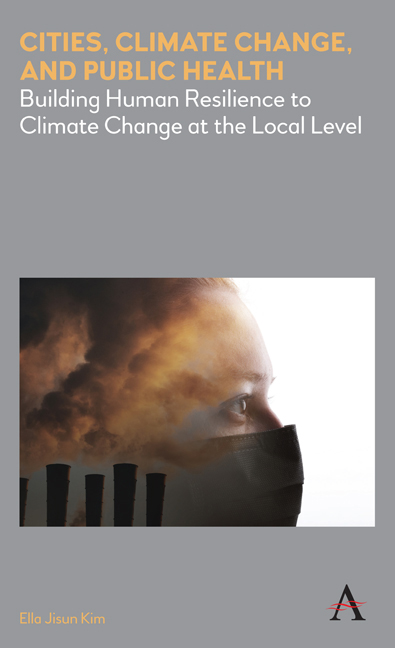 Cities, Climate Change, and Public Health
Cities, Climate Change, and Public Health Book contents
- Frontmatter
- Dedication
- Contents
- List of Figures and Tables
- Acknowledgments
- Chapter 1 Introduction
- Chapter 2 Cities, Climate Change, and Public Health
- Chapter 3 Collective Climate Adaptation at the Local Level
- Chapter 4 Framing Climate Change as a Public Health Issue
- Chapter 5 Role-Play Simulations
- Chapter 6 Digital Games
- Chapter 7 Role-Play Simulations versus Digital Games
- Chapter 8 Discussion and Policy Recommendations
- Appendix A Issue Framing Vignettes
- Appendix B Issue Framing Survey Questions
- Appendix C Role-Play Simulation Before-Survey Questions
- Appendix D Role-Play Simulation After-Survey Questions
- Appendix E Role-Play Simulation Facilitator Questionnaire
- Appendix F Role-Play Simulation Debriefing Script
- Appendix G Role-Play Simulation Post-Game Interview Questions
- Appendix H Role-Play Simulation Workshop Sample Characteristics
- Appendix I Digital Game Before-Survey Questions
- Appendix J Digital Game After-Survey Questions
- Appendix K Digital Game Post-Game Interview Questions
- Appendix L Digital Game Sample Characteristics
- References
- Index
- Frontmatter
- Dedication
- Contents
- List of Figures and Tables
- Acknowledgments
- Chapter 1 Introduction
- Chapter 2 Cities, Climate Change, and Public Health
- Chapter 3 Collective Climate Adaptation at the Local Level
- Chapter 4 Framing Climate Change as a Public Health Issue
- Chapter 5 Role-Play Simulations
- Chapter 6 Digital Games
- Chapter 7 Role-Play Simulations versus Digital Games
- Chapter 8 Discussion and Policy Recommendations
- Appendix A Issue Framing Vignettes
- Appendix B Issue Framing Survey Questions
- Appendix C Role-Play Simulation Before-Survey Questions
- Appendix D Role-Play Simulation After-Survey Questions
- Appendix E Role-Play Simulation Facilitator Questionnaire
- Appendix F Role-Play Simulation Debriefing Script
- Appendix G Role-Play Simulation Post-Game Interview Questions
- Appendix H Role-Play Simulation Workshop Sample Characteristics
- Appendix I Digital Game Before-Survey Questions
- Appendix J Digital Game After-Survey Questions
- Appendix K Digital Game Post-Game Interview Questions
- Appendix L Digital Game Sample Characteristics
- References
- Index
Summary
Recent years’ increases in the intensity, frequency, and duration of hurricanes in the Atlantic and Pacific ocean basins, along with the incidence of the most intense (Categories 4 and 5) storms, are in part due to higher atmospheric and sea surface temperatures from climate change (Emanuel 2017; Melillo et al. 2014). More importantly, even if we were to stop emitting greenhouse gases today, with the lock-in of irreversible temperature increases from past emissions, climate impacts are expected to continue for the next few centuries (IPCC 2014; Melillo 2014; Solomon et al. 2009).
In 2017, Hurricane Harvey, a Category 4 storm, dumped more than 50 inches of rain over southeast Texas, resulting in more than eighty deaths and $180 billion of damage (Amadeo 2017). The historic and catastrophic devastation caused by the storm posed a host of public health concerns. Hurricane Harvey caused more than eight hundred wastewater treatment facilities and thirteen Superfund sites with toxic chemicals to flood (Hernandez, Zezima, and Achenbach 2017). Standing water in flooded homes in Houston was found to contain up to 135 times of what is considered safe of E. coli, a measure of fecal contamination (Kaplan and Healy 2017). News stories broke of how a senior citizen and a firefighter contracted necrotizing fasciitis, or “flesh-eating bacteria,” from the contaminated floodwaters (Astor 2017). Long after the water drained and media attention subsided, post-Harvey residents had to grapple with increased risks of wound infections, diarrhea from toxic waters, and health threats from mold, mosquitoes, and other disease vectors, along with mental health stressors (Grigg 2017). The public health implications of climate change are significant.
As cities in the United States and around the world are increasingly experiencing the impacts of climate change, many are starting to include climate considerations in their planning and policymaking processes (Bierbaum et al. 2013; IPCC 2014). Cities are looking not only to mitigate greenhouse gas emissions from buildings, industries, and transportation to prevent future climate change but also to prepare for and manage climatic changes that have already been set in motion.
Urban climate adaptation to date has mostly focused on how cities can protect their physical assets from potential climate-related disasters, with an increasing emphasis on enhancing resilience, or creating places that can absorb and withstand climatic shocks (Hughes 2015).
- Type
- Chapter
- Information
- Cities, Climate Change, and Public HealthBuilding Human Resilience to Climate Change at the Local Level, pp. 1 - 4Publisher: Anthem PressPrint publication year: 2020


